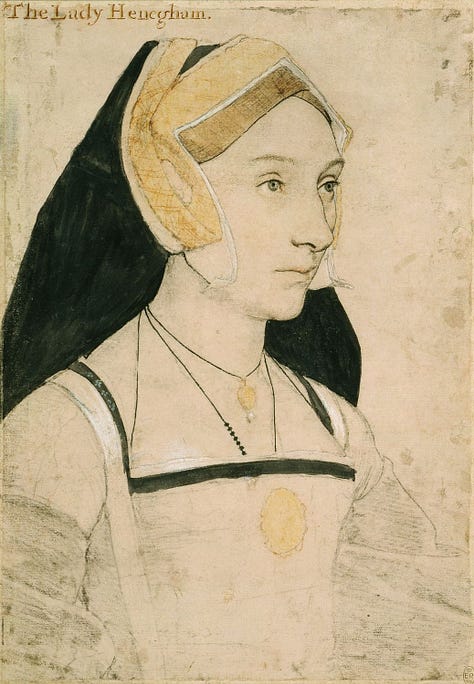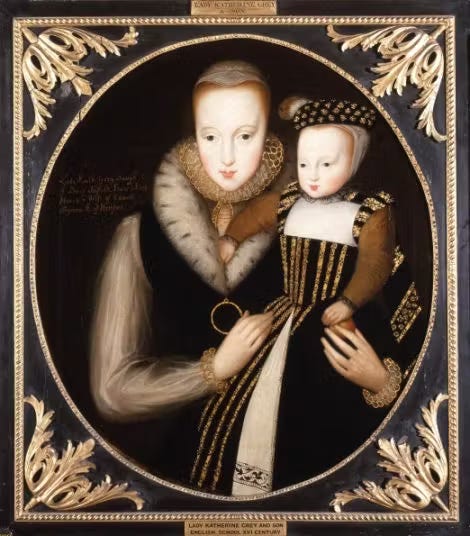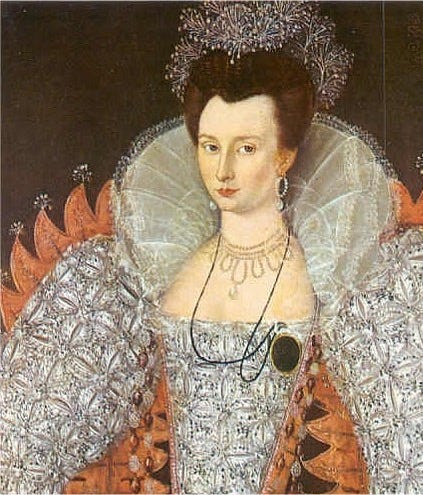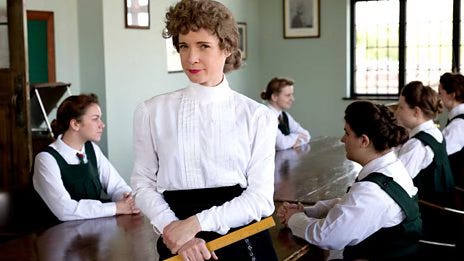How well do you know your Thomas Wolsey from your Thomas Cromwell, and your Thomas Cranmer from your Thomas More? To find out, take my Tudor test! The answers are at the bottom, along with my assessment of your performance.
Question One: An easy one, to warm up. Complete the rhyme:
Divorced, Beheaded, Died
Divorced, Beheaded …
a. Bee-hived
b. Alive
c. Survived
d. With child
Question Two: Henry VIII got married how many times? (Beware!)
a. five
b. six
c. seven
d. eight
Question Three: Which of these words is NOT a Tudor euphemism for a toilet?
a. the jakes
b. the gong
c. the Great House of Easement
d. the water-pot
Question Four: Match the personal symbol to the wife of Henry VIII:
Katherine of Aragon Falcon
Anne Boleyn Phoenix
Jane Seymour Pomegranate
Question Five: You get the chance to interview Henry VIII. How would he explain Anne Boleyn’s fall?
a. She’d had a miscarriage, and seemed unlikely to provide the vital male heir
b. He was rather taken with Jane Seymour, who’d become his next wife
c. Anne had become shrewish and had started bossing Henry about
d. Anne had been unfaithful to him, and ‘upwards of 100 gentlemen’ had known her carnally
Question Six: Who killed the most heretics?
a. Henry VIII
b. Edward VI
c. Mary
d. Elizabeth
Question Seven: Which is the motto of Elizabeth I?
a. semper eadem
b. In the end is my beginning
c. To be useful in all I do
d. The Most Happie
Question Eight: Which of these is a phrase not uttered by Tudor historian David Starkey?
a. ‘Female historians are usually quite pretty’.
b. ‘If you are to do a proper history of Europe before the last five minutes, it is a history of white males because they were the power players.’
c. ‘I’m often accused of being woke.’
d. ‘Yes, I am quite charming and kitten-like, aren’t I?’
Question Nine: Which of these ladies was punished by the jealous Virgin Queen for forming a relationship with a man?
a. Mary Shelton
b. Katherine Grey
c. Mary Fitton



Question Ten: What was the name of the little dog who cowered under the skirts of Mary Queen of Scots during her execution in 1587?
a. Fleur
b. Eliza De Ville
c. Geddon
b. Lysander
Question Eleven: Which of these people have been proposed as the ‘real’ author of William Shakespeare’s work?
a. Elizabeth I
b. Edward de Vere, seventeenth Earl of Oxford
c. Francis Bacon
d. Christopher Marlowe
Question Twelve: What would you do with a farthingale?
a. spend it
b. travel in it
c. wear it under your skirt
d. take it out hunting with you
Question Thirteen: Who should get most credit for translating the Bible into English?
a. King James
b. Saint James
c. 54 scholars appointed by King James
d. William Tyndale
Question Fourteen: Spot the odd one out:
a. Turkeys
b. Hops
c. Sweet Potatoes
d. Coffee
Question Fifteen: Make a fist and then push your thumb up between the first and second fingers. This is a rude Elizabethan gesture called ‘The Fig of Spain’. It represents:
a. The horns of a cuckold
b. The Pope’s mitre
c. The female genitalia
Question Sixteen: Why do we have the letters ‘FD’ on British coins?
a. Stands for ‘fidei defensor’, ‘Defender of the Faith’, a title first given by the Pope to Henry VIII
b. Stands for ‘Felicitous Dominions’, a description of the British Isles
c. Stands for ‘fidei defensor’, ‘Defender of the Faith’, a title first given by the Pope to Mary I
d. Stands for ‘fide et dolor’, ‘By Faith and Pain’, a motto adopted by Elizabeth I
Question Seventeen: Here is a verse about the dangers of ambition by Sir Thomas Wyatt.
These bloody days have broken my heart.
My lust, my youth did them depart,
And blind desire of estate.
Who hastes to climb seeks to revert.
Of truth, circa Regna tonat.
It was inspired by which event?
a. the loss of the tuna fishing fleet into which Wyatt had invested all his money
b. the sight of Anne Boleyn being executed at the Tower of London
c. the fall of Sir Christopher Hatton, that ‘mere vegetable of the court that sprung up at night and sank again at his noon’.
Question Eighteen: Which Thomas was forced to forfeit his Cambridge fellowship for getting married to a woman named Joan?
a. Thomas Wolsey
b. Thomas Howard, Duke of Norfolk
c. Thomas More
d. Thomas Cromwell
e. Thomas Cranmer
Answers:
Question One: c. Survived.
Question Two: seven!
He married Anne Boleyn twice: first, in secret, at Dover, then again at Whitehall Palace. Did I getcha?
Question Three: d. the water-pot
Question Four: Katherine of Aragon: Pomegranate
Anne Boleyn: Falcon
Jane Seymour: Phoenix
Question Five: d.
Note: this is a tricky area. Although Henry VIII believed that his wife had been unfaithful (the words about the ‘100 gentlemen’ are reputedly his own) it is probably the one statement of the four that wasn’t true. A., b., and c. were all contributing factors to her fall, but not so admitted by Henry.
Question Six: a.
Note: you’d be forgiven to falling foul of centuries of anti-Catholic propaganda and saying c. ‘Bloody Mary’. Accurate figures are hard to come by, but you can argue that Henry VIII killed far more many Catholics (thousands) than Mary did Protestants (hundreds).
Question Seven: a.
b. was the motto of Mary Queen of Scots
c. was Katherine Parr’s
d. was Anne Boleyn’s - as was a., which was subsequently adopted by her daughter Elizabeth.
Question Eight: c.
He said d. in an interview with Rachel Cooke for The Observer in 2012.
Question Nine: Trick question. All of them were punished.
Mary Shelton: while punishing Mary with ‘both in blows and words’ for a secret marriage, Elizabeth reputedly broke her finger
Katherine Grey: for marrying in secret she was thrown into the Tower, where, incidentally, she gave birth to her son, and also somehow managed to conceive her second child.
Mary Fitton: sent away from Court for having a lover, her mother thought it ‘such shame as never had a Cheshire woman’.
Question Ten: c. Geddon. The blood had to be washed off him afterwards.
Question Eleven: Another trick question. All have been proposed.
Question Twelve: c.
Question Thirteen: a., c. and d., all had a hand in it, but the text of the 1611 King James Bible is estimated to be 80% Tyndale’s work, done decades before. Answer therefore d.
Question Fourteen: d. Coffee is the odd one out, being first imported in the seventeenth century. The rest arrived in England in the sixteenth.
Question Fifteen: Regrettably, it’s c.
Question Sixteen: a. (Henry’s title was awarded before the Break with Rome.)
Question Seventeen: b.
Question Eighteen: e. Thomas Cranmer
Rank yourself…
Count up your correct answers and give yourself a point for each one. What rank have you achieved?
0-5: ‘Useless, boiled within thy skull.’ (Julius Caesar)
I’m sorry to say that your brain is offal.
6-10: ‘Alack, poor gentleman!’ (King Lear)
You haven’t done very well, I’m afraid.
11-15: ‘A very good piece of work, I assure you.’ (A Midsummer Night’s Dream)
Not bad at all, a solid yeoman performance.
16-18: ‘O Jesu, this is excellent sport, i’faith.’ (Henry IV, Part 2)
Well done, you’re in the aristocracy.
Fancy more Tudor shenanigans? You might like to read about the stomach and fertility of Mary I, or about the time I went to Anne Boleyn’s coronation, or even the ghosts of Hampton Court Palace.






Thanks! This was fun.
That was very good, most enjoyable. It got the old brain working after the tribulations of suffering South Western Railways.